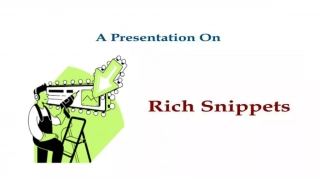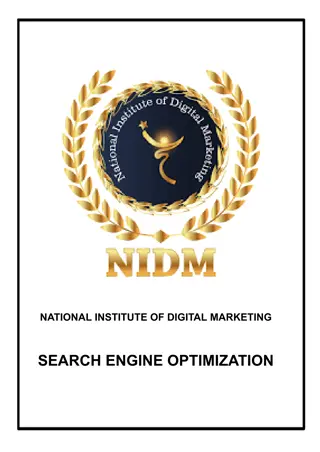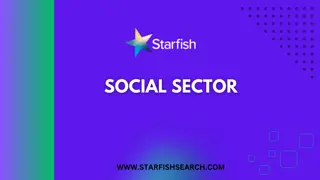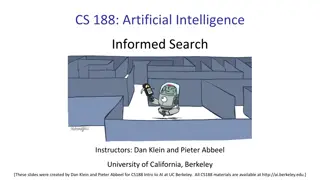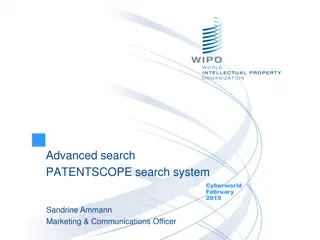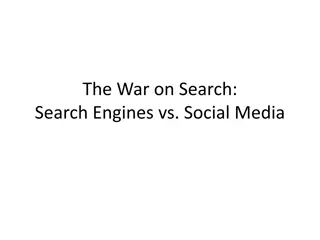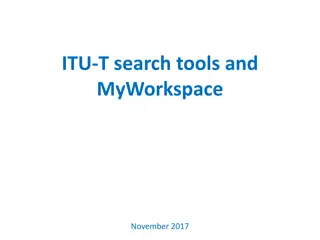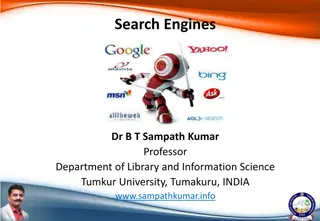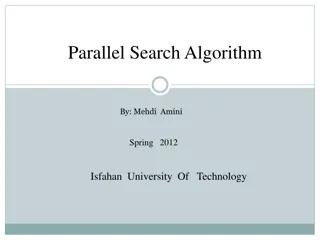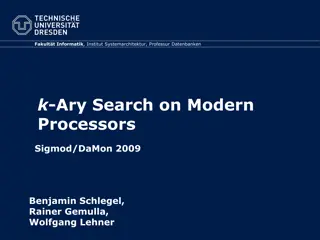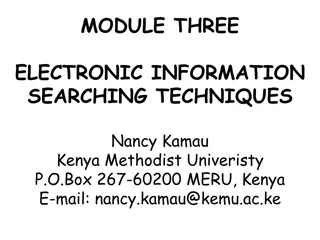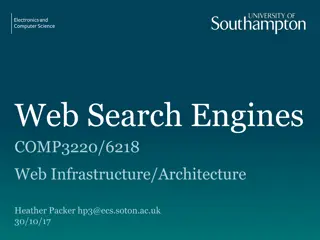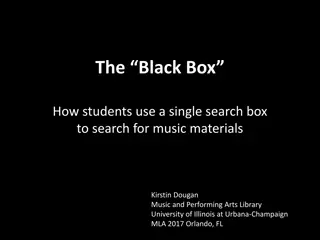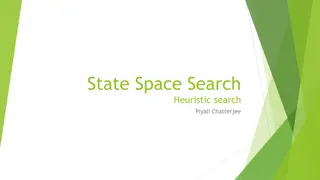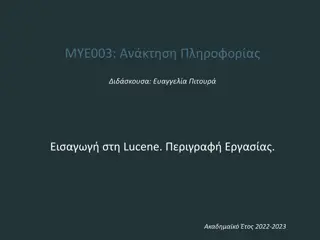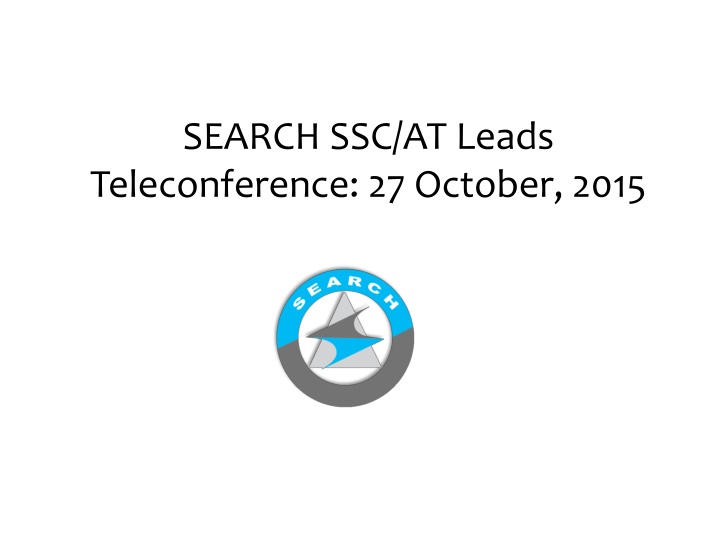
Arctic Communication Strategy Implementation by SIAT Year 2 Achievements
This content highlights the accomplishments and ongoing efforts of the Sea Ice Action Team (SIAT) in implementing a communication strategy for Arctic-related research and activities. It discusses the hiring of a communicator, development of communication avenues, collaboration across various communities, and planning for future events within the Arctic science domain.
Download Presentation

Please find below an Image/Link to download the presentation.
The content on the website is provided AS IS for your information and personal use only. It may not be sold, licensed, or shared on other websites without obtaining consent from the author. If you encounter any issues during the download, it is possible that the publisher has removed the file from their server.
You are allowed to download the files provided on this website for personal or commercial use, subject to the condition that they are used lawfully. All files are the property of their respective owners.
The content on the website is provided AS IS for your information and personal use only. It may not be sold, licensed, or shared on other websites without obtaining consent from the author.
E N D
Presentation Transcript
SEARCH SSC/AT Leads Teleconference: 27 October, 2015
November In-Person Meeting Planning Meeting goals, draft agenda, advance preparation needed, guest participation (who is being invited, what do we need to do to make the most of their involvement).
SEARCH Sea Ice Action Team Year 2 Plans
Key outcome of Year 1: Hired a SIAT Communicator/Facilitator - Matt Druckenmiller Developing and implementing an effective communication strategy in cooperation with the SIAT, key stakeholders, the scientific community, and related organizations Identifying promising communication avenues and assess the needs and interests of various potential audiences Enabling communication and collaboration across arctic community (SEARCH, science community, stakeholders, funding agencies, government, etc.) Engaging with stakeholders and members of potential audiences to assess the relevance of information related to Arctic change Determining how these activities might be applied across other SEARCH Action Teams and SEARCH in general Seeking other opportunities to communicate new Arctic-related research and activities to the general public and to specific audiences
SIAT Year 2 - Accomplishments to Date Strategy Task Force Workshop in Bristol, RI (Sept 9-10, 2015) Developed a communication strategy for implementation in Years 2-5 Transitioned the Task Force into SIAT members Strategy was circulated to the SEARCH SSC in late-Sept Planning for upcoming events: Forum for Arctic Modeling & Observational Synthesis (FAMOS) Meeting Arctic Observing Open Science Meeting AGU presentations and a science communication workshop Arctic Observing Summit (AOS)
SIAT Members Jennifer Francis (co-lead) Rutgers University Henry Huntington (co-lead) Huntington Consulting Matt Druckenmiller (science communicator) Rutgers & NSIDC Lawrence Hamilton University of New Hampshire Bob Henson Weather Underground Marika Holland NCAR Martin Jeffries Office of Naval Research Brendan Kelly SEARCH Program Don Perovich Cold Regions Research & Engineering Lab (CRREL)
SIAT Communication Strategy Key Elements: Collaboratively develop concise and accessible sea ice information, organized across high-level topics ( Sea Ice and ) Facilitate guest perspectives from science & stakeholder communities Provide timely scientific information (via Rapid Response Teams) in response to emerging high-interest topics Provide tiered access to info. via a hierarchical, pyramid structure Evaluate the usability and usefulness of provided information A web resource Sea Ice Matters will provide a platform for multi- media information and a focus for collaboration.
SIAT Year 2 Activities (1 of 3) Seeking science community feedback and building supporting partnerships FAMOS Meeting # 4 Nov 4-6, 2015 Arctic Observing Open Science Meeting Nov 17-19, 2015 SIPN post-2015 Sea Ice Outlook (SIO) Action TEAM AGU Fall Meeting Dec 13-18, 2015 Arctic Observing Summit March 15-18, 2015 Pursuing specific opportunities for supporting partnerships, e.g., Potential partnership with NSIDC s Icelights Proposal to NSF s solicitation for Advancing Informal STEM Learning from Univ. of Colorado Boulder to produce educational sea ice videos
SIAT Year 2 Activities (2 of 3) Developing foundational content and concept maps for Sea Ice Matters Demoing Sea Ice Matters, beginning with Sea ice and (1) ecosystems, (2) society, and (3) your weather Developing a mock-up of Sea Ice Matters website Seeking developer feedback Creating a plan for development support
SIAT Year 2 Activities (3 of 3) Submitted a short statement to the Arctic Observing Summit (AOS), highlighting the SIAT Communication Strategy and metrics for evaluation AGU Event: Revealing the New Arctic: A climate change communication workshop with Andrew Revkin of the New York Times Wed, Dec 16, 3:00-4:30 PM Nominating a candidate for the AAAS Public Engagement Fellows Program 2016-2017 (Nominations due Nov 1)
SEARCH Permafrost Action Team Year 2 Plans
Permafrost Action Team 1) What are your current ideas for activities, outcomes, and products for Year 2? [Also consider Q#2 and #3 in the context of these activities] Network Development Science and Action Steering Committee: (vetted by SEARCH SSG, verbal discussions with Ted (most); official appointment letters Nov 1) [this list not yet for sharing/posting] Cathy Wilson Los Alamos National Lab (NGEE Arctic) Erik Kasischke NASA (ABoVE) Dave McGuire UAF/USGS (PCN) Vladimir Romanovsky UAF (GTN-P) Kevin Bjella (CRREL) Toni Lewkowicz (U Ottawa, IPA) Merritt Turetsky (U Guelph, PCN) Dave Schirokauer (Denali NPS) Michelle Walvoord (USGS Denver) Scott Rupp (UAF, SNAP, Alaska Climate Center) Synthesis Postdoctoral Researcher. Funded by USGS Climate Science Center for 2 years (Steve Grey). Will be based at UA Fairbanks / IARC. Focused on Permafrost Impacts on Theme 2 Infrastructure, or Theme 3 Fish/Wildlife/Ecosystem Services. Work with McGuire, Schuur, Eicken, others TBD.
Permafrost Action Team 1) What are your current ideas for activities, outcomes, and products for Year 2? Science Advances Schuur E.A.G., A.D. McGuire, G. Grosse, J.W. Harden, D.J. Hayes, G. Hugelius, C.D, Koven, P. Kuhry, D.M. Lawrence, S.M. Natali, D. Olefeldt, V.E. Romanovsky, C. Sch del, K. Schaefer, M. Turetsky, C. Treat, and J.E. Vonk. 2015. Climate change and the permafrost carbon feedback. Nature 520, 171 179 Koven, C., E.A.G. Schuur, C. Sch del, T.J. Bohn, E.J. Burke, G. Chen, X. Chen, P. Ciais, G. Grosse, J.W. Harden, D.J. Hayes, G. Hugelius, E. E. Jafarov, G. Krinner, P. Kuhry, D.M. Lawrence, A.H. MacDougall, S.S. Marchenko, A.D. McGuire, S. M. Natali, D.J. Nicolsky, D. Olefeldt, S. Peng, V.E. Romanovsky, K.M. Schaefer, J. Strauss, C.C. Treat and M. Turetsky. 2015. A simplified, data-constrained approach to estimate the permafrost carbon-climate feedback. Phil. Trans. R. Soc. A 373: 20140423. Schaedel, E.A.G Schuur et al. Changing environmental controls affect the strength of the permafrost carbon feedback. Nature Climate Change, in revision Abbott, B., et al. Can increased biomass offset carbon release from soils, streams, and wildfire across the permafrost region? Nature Communications, in review Olefeldt, D., et al. Thermokarst terrain: circumpolar distribution and soil carbon vulnerability. Nature Geosciences, in review A. David McGuire, Charles Koven, David M. Lawrence, Joy S. Clein, Jiangyang Xia, Christian Beer, Eleanor Burke, Guangsheng Chen, Xiaodong Chen, Christine Delire, Elchin Jafarov, Andrew MacDougall, Sergey Marchenko, Dmitry Nicolsky, Shushi Peng, Annette Rinke, Kazuyuki Saito, Wenxin Zhang, Ramdane Alkama, Theodore J. Bohn, Philippe Ciais, Bertrand Decharme, Daniel J. Hayes, Altug Ekici, Isabelle Gouttevin, Tomohiro Hajima, Duoying Ji, Gerhard Krinner, Dennis P. Lettenmaier, Yiqi Luo, Paul A. Miller, John C. Moore, Vladimir Romanovsky, Christina Schaedel, Kevin Schaefer, Edward A.G. Schuur, Benjamin Smith, Tetsuo Sueyoshi, and Qianlai Zhuang.A model-based analysis of the vulnerability of carbon in the permafrost region between 1960 and 2009, in revision.
Permafrost Action Team 1) What are your current ideas for activities, outcomes, and products for Year 2? Outreach, Media, Decision Support Press release for: Climate change and the permafrost carbon feedback. 71 news articles published (4pm 4/10/2015) including Washington Post, The Globe and Mail, Sydney Morning Herald, The Guardian .. Press release for: A simplified, data-constrained approach to estimate the permafrost carbon-climate feedback. 6 news articles published (4pm 4/10/2015) including Daily Californian, Alaska Dispatch News, Interviews about the Alaska Fire Season: Atlantic Magazine. In Alaska, Too Many Fires, Not Enough Snow. Sept 2015 National Public Radio. Beneath Alaskan Wildfires, A Hidden Threat: Long-Frozen Carbon s Thaw. July 2015 Washington Post. Alaska s Terrifying Wildfire Season and What it Says About Climate Change. July 2015 BBC. Permafrost Warming in Parts of Alaska Is Accelerating . Oct 2015 Briefing report to International Permafrost Association. 2015. SEARCH and the Permafrost Carbon Network. Briefing report to National Academies Polar Research Board. 2015. Rapid change at the poles. Briefing report to Interagency Arctic Research Policy Committee. 2015. Permafrost Carbon Research Coordination Network Progress on Milestone 3.2.3. Materials provided to USGCRP and State Department in Advance of President Obama s presentation at the GLACIER conference. August 2015. https://www.whitehouse.gov/2015-alaska-trip?sid=123 Public Outreach Article: World Wildlife Foundation. The Circle. Permafrost Carbon and Climate Change. Oct 2015.
Permafrost Action Team 1) What are your current ideas for activities, outcomes, and products for Year 2? Upcoming Hosted Workshops 6th Annual Open Science Meeting of the Permafrost Carbon Network. Held prior to AGU (Sunday Dec 13, 2015). This network meeting draws in new participants and solicits feedback on upcoming synthesis products. [details on next slide] Methane Synthesis Workshop. (Mar/April 2016, Fairbanks, AK?) [Potential opportunities here to cross cut with sea-ice via subsea methane / interest from FAMOS group]. This workshop will focus in more detail on four methane synthesis products outlined at Open Science PCN meeting. Synthesis Lead Workshop. Held in conjunction with Eleventh International Conference of Permafrost (ICOP), Potsdam, Germany (June 2016). This smaller workshop brings lead / co-lead scientists of synthesis products together for cross- cutting opportunities.
Permafrost Action Team 1) What are your current ideas for activities, outcomes, and products for Year 2? Science Advances / Next Round Synthesis Products 1) Benchmarking and improving interactions with the Earth System Modeling Community Lead: Charlie Koven, Dave Lawrence, Loranty 2) Methane syntheses Lead: Dave McGuire 3) Geospatial analyses: dynamic landscape controls on permafrost carbon vulnerability Lead: Dan Hayes, David Olefeldt 4) Quantifying relationships between vegetation structure and permafrost thermal dynamics Lead: Mike Loranty 5) Where and when will the Arctic become wetter or drier? Lead: Cathy Wilson 6) Dissolved organic matter composition in waters draining permafrost landscapes Lead: Jon O Donnell 7) Carbon emission from the arctic during the non-growing season Lead: Sue Natali 8) Greening versus browning of the Arctic Lead: Christina Sch del 9) Yedoma carbon stocks and other deep permafrost C Lead: Jens Strauss 10) Synthesizing the use of carbon isotope (14C and 13C) approaches to understand rates and pathways for permafrost C mobilization and mineralization Lead: Cristina Estop-Aragones 11) The depth distribution of soil carbon: quantification of northern profile datasets Lead: Jen Harden, Claire Treat, and Charlie Koven
Permafrost Action Team 1) What are your current ideas for activities, outcomes, and products for Year 2? Contributions to Other Networks and Activities: Organized Sessions at AGU Annual Meeting. B093:Vulnerability of Permafrost Carbon to Climate Change (Session ID#: 8594) Conveners: Christina Schaedel, Ted Schuur, Cristian Estop-Aragones Poster session will take place Wednesday, December 16, 8:00 am 12.20 pm, Moscone South, Poster Hall Oral Sessions will take place Thursday, December 17, 8:00 am - 4:00 pm, Moscone West, 2004 Special Session including a panel discussion with PCN, NGEE Arctic, will take place Thursday, December 17, 4:00 pm 6:00 pm, Moscone West, 2004 AMAP Synthesis: Snow, Water, Ice, Permafrost in the Arctic. 2016. Contribution to Carbon Chapter. Climate in Cryosphere (WCRP CliC): Permafrost and Modeling Forum. Development of Grand Challenges. IASOA Flux Activity (NOAA). Call for Organizing Committee Nominations by November 6, 2015 Advancing Integrated, Cross-cutting Practices for Arctic Flux Observations in Terrestrial Environments. S. Starkweather, E. Euskirchen leads. IARPC Milestones; Terrestrial Ecosystems Impact Team, Carbon Observation Strategy (NOAA). January 5-7, 2016. A. Andrews lead.
Permafrost Action Team 4) Is there anything you need from other Action Teams or the SSC? Partnerships for workshop support. Workshop $ is leveraged between SEARCH and other interested groups. Partnerships for synthesis and networking postdoctoral research support. 1 year synthesis postdoc $ can make rapid progress on synthesis products where groundwork (scoping, preliminary data) has been laid by PCN working groups.
SEARCH Land Ice Action Team Year 2 Plans
Land Ice Action Team F. Straneo (WHOI), T. Scambos (NSIDC) Greenland Ice-Ocean Observing System (GrIOOS) Workshop Dec 12-13th San Francisco Target: design and implementation of GrIOOS: provide long-term time series of in situ glaciological, oceanographic and atmospheric parameters at several key locations Motivation: information on the time-evolving relationships between the different climate forcings and glacier flow. A key priority in the 2013 GRISO workshop and report. Specific goals of the GrIOOS workshop are to discuss: the scientific motivation for specific measurements; integration with existing related long-term measurements around Greenland; identification of key sites for monitoring interactions; identification of instrumentation.
Land Ice Action Team F. Straneo (WHOI), T. Scambos (NSIDC) Greenland Ice-Ocean Observing System (GrIOOS) Workshop Dec 12-13th San Francisco Steering Committee: J. Abermann (Asiaq, Greenland), A. Ahlstr m (GEUS, DK),G. Hamilton (U Maine, USA), P. Heimbach (UT Austin & MIT, USA), R. Mottram (DMI, DK), S. Nowicki (NASA Goddard, USA), T. Scambos (NSIDC, USA), F. Straneo (WHOI, USA), D. Sutherland (U Oregon, USA), M. Truffer (U Alaska, USA) Solicited Expression of Interest; Selected ~45 attendees from 7 different countries, including oceanographers, glaciologists, climate modelers, ice sheet modelers, marine biologists, spanning different career stages and balanced gender representation; Invited 7 program managers from US and Danish funding agencies; Invited members of Greenland s government; Obtained additional CliC sponsoring; Co-organized with ISMIP Meeting (same location, shared session). Workshop Report will be drafted in the winter and circulated for community feedback Expected completion date ~ April 2016
Land Ice Action Team F. Straneo (WHOI), T. Scambos (NSIDC) Additional Plans Hire a post-doc based at WHOI, extended visits to NSIDC; part of post-doctoral research to focus on topics identified in the workshop report; Elaborate on Report outcomes; - - Define synthesis products possible products include: Arctic sea level rise Freshwater from Arctic Land Ice change synthesis
SEARCH AON/OCP Year 2 Planning (Craig) What can/should SEARCH be doing over the coming year to advance Arctic Observing? What are the highest priorities? What kinds of activities would be needed and what would it take to achieve these? How would activities focused on Arctic observing intersect with the SEARCH Science Themes/Action Teams, and other cross-cutting activities (e.g. scenario development, knowledge exchange)?
Cross-Cutting Activities & Arctic Observing Update (Hajo) - - - Year 2 Planning: Possible cross-cutting activities Vision documents: Update, next steps AOS white paper(s)
Cross-Cutting Year 2 Activities Arctic Futures 2050 Scenario Development Arctic State Variables A review of different approaches to ID variables, select a set and assess co-variance. Permafrost AT s plans for an Undersea Permafrost/Methane Workshop in March relevance to US Arctic Council Chairmanship Others?
Framework for effective & sustained observations of rapid Arctic change Meeting at OSTP in 2014 to explore options for sustained, cross-agency observations Demonstrated national shortfall, urgency, relevance GLACIER Conference 31 Aug 2015 Arctic Executive Steering Committee (AESC) NSF-AON NOAA sustained observations now & in the future Other relevant efforts such as TEON, industry efforts etc. By design agency missions & mandates result in a patchwork of activities: can SEARCH help?
Different types of information needs & observations: NSF Observations for research Mission agencies Observations for operations Stakeholders & others Observations for operations and long-term planning Frameworks for prioritization & coordination: System services, Societal Benefit Areas, etc. Role of IARPC, SEARCH & AESC Regulating climate retention of surface water Provisioning subsistence stable platform System Services Arctic Environmental Systems Arctic Social Systems Cultural cultural landscape learning & knowledge Supporting biodiversity sea-ice substrate Actors: Arctic residents, corporations, government agencies, etc.
Desired outcomes: Planning, prediction, scenarios, regulations, emergency response, economic incentives etc. Regulating Climate: DOE, NASA, NOAA, NSF, etc. Radiative forcing, air temp., albedo, snow & ice extent, etc. Species abundance & health, nutrients, hunting pressure etc. Target Variables Arctic Environmental Systems Arctic Social Systems Provisioning Subsistence: Co-management Boards, ADFG, USFWS, etc. System Services & Agencies Cultural Learning: Elders, NSBSD, DoEd, AEWC, BWCA, etc. Supporting Substrate: NSB, ASRC, BLM, etc. Proficiency in indigenous language, subsistence knowledge Permafrost thermal state, etc. IAOS AON AON Actors: Arctic residents, corporations, government agencies, etc.
Potential NSF-AON Objectives (i) Guide the overall design and implementation of an observing network and system of systems: Concepts, state variables/indicators, tactics-scale design (e.g., OSSEs) (ii) Identify and synthesize emerging scientific findings: Guide new types of observations (variables tracked, regional focus, cross-disciplinary linkages) (iii) Develop new methodological approaches and innovative technologies: Reducing logistics costs, enhancing year-round access and presence, decreasing operational risks, providing near-realtime data (iv) Identify synergiesand innovative collaborative approachesacross agencies and stakeholders: Serve research interests, increase return-on- investment for IAOS elements (v) Track key state variables for a core set of measurements at the pan- Arctic level: AON as backbone or sandbox for an IAOS; focus on key variables of high scientific priority not captured by other programs (vi) Conduct intensive observation phases: Tie into SEARCH 5-year priorities and efforts such as YOPP
Arctic Observing Open Science Meeting The meeting is at full capacity: 207 registrants! We ve received nearly 170 abstracts We re supporting the participation of 7 early career researchers with NSF funding, ARCUS frequent flyer miles, a small amount of funding from NASA. The agenda for the 1st day plenary and agency panel is now on the SEARCH website: http://www.arcus.org/search- program/meetings/2015/aoosm Parallel sessions are now being finalized and will also be posted online soon.
Other Agenda Items SEARCH at Arctic Encounter Symposium, 15-16 January in Seattle, WA: www.arcticencounter.com/seattle-2016 SEARCH at AGU SEARCH Town Hall: 16 December 12:30-1:30pm Please send other event updates to brit@arcus.org Other items?

